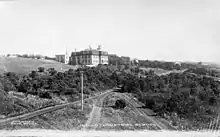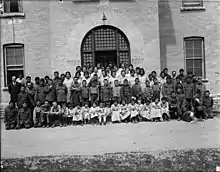Brandon Indian Residential School
The Brandon Indian Residential School was a former school located in Brandon, Manitoba. It was a part of the former Canadian Indian residential school system.
| Brandon Indian Residential School | |
|---|---|
 The school in 1920 | |
| Location | |
Canada | |
| Information | |
| Former name | Brandon Industrial Institute |
| Type | Canadian Indian residential school |
| Religious affiliation(s) | Methodist Church of Canada, United Church of Canada, Catholic Church in Canada |
| Established | 1895 |
| Closed | 1972 |
| Authority |
|
| Oversight | Crown–Indigenous Relations and Northern Affairs Canada |
| Gender | Coed |
| Language | English |
History

Five kilometres northwest of Brandon, Manitoba, the Brandon Indian Institute was established in 1895 by the Department of Indian Affairs. The school closed in 1972.[1] From 1895 to 1925, the Mission Board of the Methodist Church initially managed the school, intended for children from north of Lake Winnipeg. The United Church of Canada ran the school 1925 to 1969, and the Missionary Oblates of Mary Immaculate from 1969 to 1972.[2]
Mortality

Records of deaths at the school were spotty and inconsistent. The 1905 annual report of the Department of Indian Affairs’ annual report noted five deaths, and Methodist Church records, only three in that year. In the 77 years the school was open, only nine deaths there were registered with the Manitoba Vital Statistics Agency.[3]
The Truth and Reconciliation Commission of Canada found that over the 120 years of the program, 3,200 children minimum died at residential schools—one in 50 students, comparable to the death rate of Canadian POWs in Nazi custody.[4]
Burials
An investigation of cemeteries and unmarked graves at the Brandon school site began in 2012, a collaboration of the Sioux Valley Dakota Nation (SVDN) and researchers from Simon Fraser University, Brandon University and the University of Windsor, with the goal of identifying the children buried on the site.[5] A statement by SVDN Chief Jennifer Bone said that the project had identified 104 potential graves in three cemeteries. Cemetery and burial records account for only 78. In addition to two previously known cemeteries, the project has found a possible third burial site.[6] The project received funding to continue its work in April 2019, but work has been delayed due to the COVID-19 pandemic.[7] One of the burial grounds is now an RV campground.[8]
References
- Sioux Valley Dakota Nation working towards identifying children at Brandon residential school. Darrell Stranger, APTN, and was eventually demolished in 2006. Jun 10, 2021
- United Church of Canada. Brandon Industrial Institute/Residential School. United Church Archives.
- Douglas Quan. 'This is somebody’s young kid': The unmarked graves of Brandon’s residential school: The small cemetery just north of the school has a cairn listing 11 students, but Katherine Nichols had heard whispers in the community about unmarked graves, and how they weren’t well-kept. She was certain there were secrets to be revealed. National Post, May 15, 2015
- Tristin Hopper. Why so many children died at Indian Residential Schools: At some schools, annual death rates were as high as one in 20. National Post, May 29, 2021
- Simon Fraser University. Finding Indigenous Children: The Brandon Indian Residential School Project. June 04, 2021
- CBC. Where were Manitoba's residential schools and what stands there now? June 6, 2021
- Stranger, Darrell (June 10, 2021). "Sioux Valley Dakota Nation working towards identifying children at Brandon residential school". APTN National News. Retrieved June 12, 2021.
- Mark Neufeld, RV campground on former Manitoba residential school graveyard is degrading: family member of deceased. City News, June 2, 2021